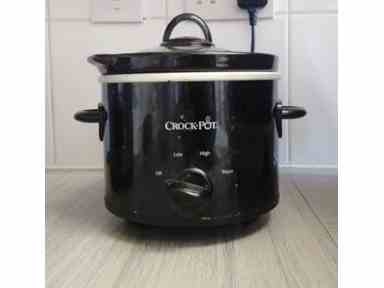Slow Cooker Reminder Page
I don’t get to use the slow cooker often. But if I do, I use it muchly. So I need a list of reminders how to use these things.

Cooker instructions
Aside from the implications that slow cookers are electrical and get hot,
Should be 1/2 to 3/4 full of liquid (slow cookers depend on the water to maintain their temperature correctly)
Difference between low and hot heats is usually cooking time (not effect, but low is better, especially for meat). ‘Medium’ (if there is no medium, ‘Low’) usually takes 7–8 hrs to cook a pot of most things, ‘hi’ usually takes about 5 hrs
Always use the lid. It’s an important part of how this works. Morphy Richards say every time you lift it adds 10–15 mins to cooking time
Most instructions say the ceramic pot, without it’s lid, can be used in an oven or microwave
The lid can be put in a dishwasher. The pot can be put in a dishwasher if it is not a raw clay base (which may discolour and wear out)
Crockpot notes
Crockpot are an American manufacturer of slow cookers. Their slow cookers,
don’t always have lights to show the cooker is on
have a ’warm’ setting. This is for keeping food warm, not for cooking (Crockpot advise not more than 4 hours on ‘warm’. Probably because the food keeps cooking, and for food hygiene)
Cooking instructions
Everything should be under water from the start. If anything sticks out, it will cook in the steam, but not so well (could be dangerous with raw meat)
Seafood, fish, cream and milk do not work. Seafood and fish will become tough. Cream and milk disintegrate. Any of these are best added in a last mixin step
Pasta and rice do not work. A slow cooker can’t cook very well ‘pasta’ or ‘rice’ standalone. These are best cooked elsewhere (unless using as a bulking agent, in which case add maybe 40mins before end e.g. Minestrone Soup)
Beans are conflicted. A slow cooker should be ideal for beans—Cassoulet, yes? But all beans should be boiled before use— without this, kidney beans can be poisonous. Best bets—boil dried beans alone first—especially no acid or sugar. Usual solution—‐used canned beans which are pre‐boiled
Vegetables take longer to cook therefore are best near the bottom or sides. In conflict, you’ll want larger pieces of meat like chops towards the bottom also
Food is unmoved in a slow cooker. I assume it’s the lack of a hard boil. Even mushy veg like potatoes or chopped tomatoes will stay in shape. Sometimes this is good, but if not, mush the veg, or some of the veg, before the end of cooking
Little water escapes, so use as little water as possible. Especially if adapting non‐slow‐cook recipes
Slow‐cooked food, especially veg, can produce a lot of water. A vegetable stew will end with a lot of liquid. You need to adjust non slow‐cooker recipes
Instructions will say frozen ingredients should be thawed. The food hygiene danger is mostly to do with meat—if you cook the outside of frozen raw meat, it warms too slow which allows microbes to develop at the 30° borderline. I’m no expert, but if you have small items of frozen food—peas, chipolatas etc.—I’d say they can be thrown into an already hot pot. Indeed, I’d suspect slow cookers are a safer way to cook than the usual roasts
Crockpot make a puzzling suggestion about frozen food (which would use kettle water),
When cooking frozen meats, at least 1 cup of warm liquid must first be added. The liquid will act as a “cushion” to prevent sudden temperature changes. An additional 4 hours on LOW or 2 hours on HIGH is typically required
This advice seems more like it’s there to protect against breaking the pot than for food hygiene
Cooking suggestions
Most slow cooker recipes start with frying onions. Onions add a mush, and if fried slightly roasted taste, to recipes. There are times when pre‐frying is impossible—there’s a little community online for ‘dump and go’ recipes or,
Onion with no pre‐fry. Usual talk online is of meat in some kind of sauce, with the onion chopped small (e.g. Chillis)
Use a pre‐made sauce (sometimes in ‘add can of soup’ recipes, but you could also use pre‐made pasta sauces)
Don’t use onion (sometimes in bean recipes, which get a little sticky from the beans)
Make an alternative sauce such as chinese‐style OK, plum or lemon
Slow‐cooker recipes can be very watery. Many slow‐cooker recipes, to counter this, heap in spices. Other ways,
Mush veg partway along
Use a thickener like lentils, or dry fruit
Create gravy—sprinkle in a few tablespoons of cornflower, or throw in some torn up bread. Oh, ok, it may be neater, like French cooks, to stir liquid into cornflower but slow cooking will break down even big lumps of flour and breadcrumbs. For cooking purposes, maybe thicken sauces later in cooking. I near‐never see the gravy route in recipes, but it works
There’s a small set of recipes do breadcrumb/stuffing crusts on savoury things, and crumble on sweet things. I can’t see this being as good as an oven, but likely more reliable. I’d give it a go